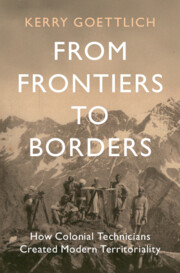Refine search
Actions for selected content:
157 results
Chapter 3 - World Literature as a Planned Economy
-
- Book:
- Five Economies of World Literature
- Published online:
- 09 December 2025
- Print publication:
- 31 December 2025, pp 79-106
-
- Chapter
- Export citation
15 - The Crimea Annexation and the Russia–Ukraine War
- from Part IV - The Nuclear Era
-
- Book:
- Crises, War, and Diplomacy
- Published online:
- 07 November 2025
- Print publication:
- 20 November 2025, pp 336-366
-
- Chapter
- Export citation
17 - General Lessons
- from Part V - Conclusion
-
- Book:
- Crises, War, and Diplomacy
- Published online:
- 07 November 2025
- Print publication:
- 20 November 2025, pp 386-402
-
- Chapter
- Export citation
9 - The Birth of Code/Body
- from Part II - Living the Digital Life
-
-
- Book:
- Being Human in the Digital World
- Published online:
- 11 November 2025
- Print publication:
- 20 November 2025, pp 129-142
-
- Chapter
-
- You have access
- Open access
- HTML
- Export citation
Holding the World Together? The Future of Territorial Order
-
- Journal:
- International Organization / Volume 79 / Issue S1 / December 2025
- Published online by Cambridge University Press:
- 20 November 2025, pp. S209-S223
- Print publication:
- December 2025
-
- Article
-
- You have access
- Open access
- HTML
- Export citation

From Frontiers to Borders
- How Colonial Technicians Created Modern Territoriality
-
- Published online:
- 23 October 2025
- Print publication:
- 06 November 2025
7 - Decolonization and the Struggle for Kenya’s “Migrated Archives”
- from Part II - Struggle to Reveal
-
- Book:
- Curating the Colonial Past
- Published online:
- 12 September 2025
- Print publication:
- 02 October 2025, pp 236-276
-
- Chapter
- Export citation
Chapter 14 - The Land of Many Laws
- from Part III - Exits
-
-
- Book:
- Colonialism and the EU Legal Order
- Published online:
- 14 October 2025
- Print publication:
- 18 September 2025, pp 314-342
-
- Chapter
-
- You have access
- Open access
- HTML
- Export citation

Fractured Pasts in Lake Kivu’s Borderlands
- Conflicts, Connections and Mobility in Central Africa
-
- Published online:
- 17 July 2025
- Print publication:
- 31 July 2025
Chapter 16 - Capitalism and Racial Form in Three Contemporary US Poets
- from Part II - Histories
-
-
- Book:
- Money and American Literature
- Published online:
- 03 July 2025
- Print publication:
- 17 July 2025, pp 274-292
-
- Chapter
- Export citation
Sketches of fairness in EU and international law. Focus on the asylum and migration pact
-
- Journal:
- European Law Open / Volume 4 / Issue 3 / September 2025
- Published online by Cambridge University Press:
- 14 July 2025, pp. 481-504
-
- Article
-
- You have access
- Open access
- HTML
- Export citation
Chapter 2 - The Overflows of Water in Latinx Literature
- from Part I - Shifting Coordinates
-
-
- Book:
- Latinx Literature in Transition, 1992–2020
- Published online:
- 19 June 2025
- Print publication:
- 03 July 2025, pp 43-58
-
- Chapter
- Export citation
Translating ‘Tibet’: the geographic extent of Bod in Tibetan historiographies
-
- Journal:
- Journal of the Royal Asiatic Society / Volume 35 / Issue 3 / July 2025
- Published online by Cambridge University Press:
- 20 August 2025, pp. 539-559
- Print publication:
- July 2025
-
- Article
- Export citation
Border Memory and the Politics of Territoriality in the Russian-Finnish Borderland
-
- Journal:
- Nationalities Papers / Volume 53 / Issue 6 / November 2025
- Published online by Cambridge University Press:
- 24 June 2025, pp. 1221-1245
-
- Article
-
- You have access
- Open access
- HTML
- Export citation
Gothic humanitarianism: Moving beyond the securitised approach to migration while embracing fear
-
- Journal:
- Review of International Studies / Volume 51 / Issue 5 / September 2025
- Published online by Cambridge University Press:
- 20 June 2025, pp. 839-859
- Print publication:
- September 2025
-
- Article
-
- You have access
- Open access
- HTML
- Export citation
Democracy, diversity, and disavowal: Tracing colonial lineages in India’s long wars
-
- Journal:
- Review of International Studies , First View
- Published online by Cambridge University Press:
- 20 June 2025, pp. 1-23
-
- Article
-
- You have access
- Open access
- HTML
- Export citation
6 - Dehumanising Refugees
- from Part II - Confronting Global Contradictions
-
- Book:
- Global Crisis and Insecurity
- Published online:
- 01 June 2025
- Print publication:
- 12 June 2025, pp 132-153
-
- Chapter
- Export citation
Chapter 13 - Translocality and Translocalism
- from Part II - Developments
-
-
- Book:
- Space and Literary Studies
- Published online:
- 07 May 2025
- Print publication:
- 22 May 2025, pp 216-233
-
- Chapter
- Export citation
10 - Migration and European History’s Global Turn
-
-
- Book:
- Globalizing Europe
- Published online:
- 06 March 2025
- Print publication:
- 13 March 2025, pp 138-158
-
- Chapter
- Export citation
1 - Global Europe
-
-
- Book:
- Globalizing Europe
- Published online:
- 06 March 2025
- Print publication:
- 13 March 2025, pp 1-26
-
- Chapter
- Export citation
